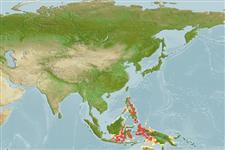Environment: milieu / climate zone / depth range / distribution range
Écologie
marin récifal; non migrateur; profondeur 5 - 33 m (Ref. 5222). Tropical; 20°N - 12°S, 111°E - 149°E (Ref. 5222)
Western Pacific: Philippines, Indonesia (Sulawesi, Flores), and Papua New Guinea.
Taille / Poids / Âge
Maturity: Lm ? range ? - ? cm
Max length : 25.0 cm TL mâle / non sexé; (Ref. ); common length : 20.0 cm TL mâle / non sexé; (Ref. )
Épines dorsales (Total): 9; Rayons mous dorsaux (Total): 14; Épines anales 3; Rayons mous anaux: 8. Similar to the more common Cephalopholis spiloparaea but lacks banding in the caudal fin (Ref. 48635); characterized further by reddish brown color; base of pelvic fins with indistinct dark blotch; greatest body depth 2.5-2.9 in SL; rounded caudal fin; short pelvic fins, 2.3-2.5 in head length; strongly bilobed margin of front of upper lip (Ref. 90102); head length 2.1-2.3 times in SL; rounded preopercle, posterior edge finely serrate, lower edge fleshy; very convex upper edge of operculum; maxilla extends past eye; teeth large; midlateral-body scales ctenoid (Ref. 89707).
Inhabits protected or silty reef areas (Ref. 89707). Reported to be very habitat speciific, lives in very rich invertebrate habitat in the shore side of inner reefs and difficult to get shots u/w. Largest seen was about 25 cm, but usually smaller up to about 20 cm (R. Kuiter, pers. Comm. 03/2022). Maximum length given 40 cm TL (for confirmation) May undergo protogyny. Solitary (Ref 90102).
Life cycle and mating behavior
Maturité | Reproduction | Frai | Œufs | Fécondité | Larves
Heemstra, P.C. and J.E. Randall, 1993. FAO Species Catalogue. Vol. 16. Groupers of the world (family Serranidae, subfamily Epinephelinae). An annotated and illustrated catalogue of the grouper, rockcod, hind, coral grouper and lyretail species known to date. Rome: FAO. FAO Fish. Synop. 125(16):382 p. (Ref. 5222)
Statut dans la liste rouge de l'IUCN (Ref. 130435)
Menace pour l'homme
Harmless
Utilisations par l'homme
Pêcheries: sans intérêt
Plus d'informations
PaysZones FAOÉcosystèmesOccurrencesIntroductionsStocksÉcologieRégime alimentaireÉléments du régime alimentaireConsommation alimentaireRation
Noms communsSynonymesMétabolismePrédateursÉcotoxicologieReproductionMaturitéFraiRassemblement de ponteFéconditéŒufsDéveloppement de l'œuf
RéférencesAquacultureProfil d'aquacultureSouchesGénétiqueElectrophoresesHéritabilitéPathologiesTraitementNutrientsMass conversion
CollaborateursImagesStamps, Coins Misc.SonsCiguateraVitesseType de nageSurface branchialeOtolithesCerveauxVision
Outils
Articles particuliers
Télécharger en XML
Sources Internet
Estimates based on models
Preferred temperature (Ref.
123201): 28 - 29.1, mean 28.5 °C (based on 68 cells).
Phylogenetic diversity index (Ref.
82804): PD
50 = 0.5000 [Uniqueness, from 0.5 = low to 2.0 = high].
Bayesian length-weight: a=0.01259 (0.00590 - 0.02687), b=3.04 (2.87 - 3.21), in cm total length, based on LWR estimates for this Genus-body shape (Ref.
93245).
Niveau trophique (Ref.
69278): 4.0 ±0.7 se; based on size and trophs of closest relatives
Résilience (Ref.
120179): Haut, temps minimum de doublement de population inférieur à 15 mois (Preliminary K or Fecundity.).
Fishing Vulnerability (Ref.
59153): Low vulnerability (15 of 100).
Nutrients (Ref.
124155): Calcium = 47.3 [25.4, 82.5] mg/100g; Iron = 0.488 [0.263, 0.915] mg/100g; Protein = 18.7 [16.9, 20.4] %; Omega3 = 0.16 [0.10, 0.26] g/100g; Selenium = 33.2 [15.9, 57.7] μg/100g; VitaminA = 108 [37, 349] μg/100g; Zinc = 0.835 [0.594, 1.369] mg/100g (wet weight);
